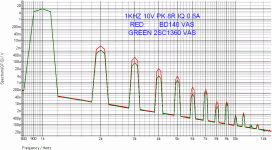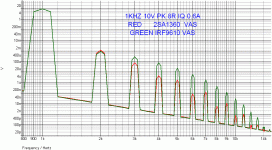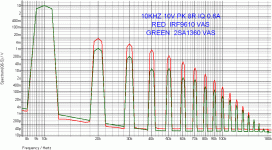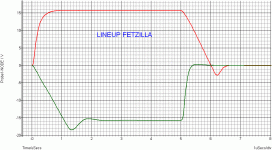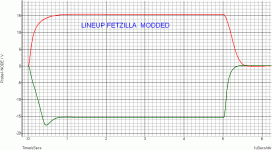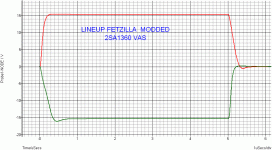Actually, SWF, I quickly alighted on your opinion as being worth far more than either the design purists or the sim jockeys....
Listening HAS to count for something. After all, lots of audiphiles say, 'Never buy anything you haven't heard'.
Now why is that? Don't the measurements and sims give reliable predictions on how it will sound? No? Gee, have to think about this a bit......
Hugh
Listening HAS to count for something. After all, lots of audiphiles say, 'Never buy anything you haven't heard'.
Now why is that? Don't the measurements and sims give reliable predictions on how it will sound? No? Gee, have to think about this a bit......
Hugh
Hugh
You might like the sound of BJT VAS cascode version. It has .003% THD ( rather than .002% with FET VAS ) this achieved with an average of about 10dB less OLG and a nice H2 H3 H4 . . . .signature.
I like to get my head really into a design in spice to learn what I can about it but now I'm going to stop spicing and start building. I plan to try a few variations, and this cascoded VAS will be one of them - it strikes me that if ever there was a good place for a cascode the VAS would be it and in this design it adds almost 30dBs of OLG ! in the bass region.
You might like the sound of BJT VAS cascode version. It has .003% THD ( rather than .002% with FET VAS ) this achieved with an average of about 10dB less OLG and a nice H2 H3 H4 . . . .signature.
I like to get my head really into a design in spice to learn what I can about it but now I'm going to stop spicing and start building. I plan to try a few variations, and this cascoded VAS will be one of them - it strikes me that if ever there was a good place for a cascode the VAS would be it and in this design it adds almost 30dBs of OLG ! in the bass region.
Last edited:
swordfishy,
As I have stated before I think you have ably demonstrated to "hear" the characteristics of this design at it's different stages of development and your feedback has been invaluable - thanks a lot
I now have a cartoon type vision of you and your family watchng TV in a anechoic chamber
mike
As I have stated before I think you have ably demonstrated to "hear" the characteristics of this design at it's different stages of development and your feedback has been invaluable - thanks a lot
I now have a cartoon type vision of you and your family watchng TV in a anechoic chamber
mike
Yes, I must apologise for having to live with my audio setup in an ordinary house rather than an anechoic chamber, for not having 5 sets of $100k speakers and amplifiers in a setup which allows easy switching, and for not having a team of ready participants for a blind A/B test. I must also apologise for being tired on some days, mad on others and happy on even more, and for letting that influence my impressions.
I must apologise for building perhaps 10 incarnations of this circuit with an open mind, for trying mosfets, jfets and BJTs in most of the critical parts of the circuit, for listening for hours and finally deciding on the circuit which I had been most against at the outset.
And finally, I must apologise that the circuit I decided on, unbeknown to me, also happened to have the most favourable simulation character.
Yes, my opinion means nothing. Maybe someone else will build the amplifier too and prove me wrong, and maybe they will have the anechoic chamber and ideal listening conditions too. Just like all of us hobbyists who are just doing this for the fun and passion of it have.
Seriously though, someone else please build it and let us know what you think.
In the meantime I'm going to enjoy building simple circuits that sound nice to my ears and conversing about it with nice open people on the forum. I also hope the guy who bought my Doug Self blameless amplifier is enjoying its miniscule distortion, high level of detail and lack of soul.
if you choose to go down this path in full knowledge of established psychoacoustic testing standards/practices and the reasons for them then fine - it is your time and it sure beats football hooliganism on social utility
your "results" are less useful to anyone except yourself if you forgo well established controls in your listening
the overwhelming bias from the marketing, reviewers, magazines leads many to what I characterize as "naive subjectivism" where "just listen" is the only rule
the industry puts far more cash into creating the idea of audio connoisseurism to sell elaborate "stories" than actual circuit development
ABX/DBT results should be important to dedicated subjectivist - anything that can be heard in such "stressful", "low resolving" conditions certainly must contaminate any "deeper" listening test and needs to be controlled for/removed to get meaningful subjective results
All,
I was having a bit of fun and merely joking about how no one can fairly expect a hobbyist to really do any more than I have, which is build and listen under sub optimal conditions. I'm not in any way bothered or put off by any negative commentary.
I do have concerns that our listening impressions won't align when it comes to how this amplifier sounds, but that is the nature of audio. Hopefully soon mikelm at least will be able to comment.
Thanks to those of you who have been supportive and guided me through this process with encouragement. Hugh, Mikelm and lineup especially.
This has been fun and I find the dialogue between the various audio camps quite entertaining.
I was having a bit of fun and merely joking about how no one can fairly expect a hobbyist to really do any more than I have, which is build and listen under sub optimal conditions. I'm not in any way bothered or put off by any negative commentary.
I do have concerns that our listening impressions won't align when it comes to how this amplifier sounds, but that is the nature of audio. Hopefully soon mikelm at least will be able to comment.
Thanks to those of you who have been supportive and guided me through this process with encouragement. Hugh, Mikelm and lineup especially.
This has been fun and I find the dialogue between the various audio camps quite entertaining.
JCX,
You are such a useful fellow, aren't you? Always lording it over others, airing your knowledge?
Have you considered collecting for the Salvation Army?
Hugh
Ah Hugh,
I think were we to meet in person you would find that we share the same sense of humour!
Hi, SWF, Hugh, Mikelm and MiiB.
I was looking at the startup pulse. You could alter the circuit to remove this pulse, but i think it will mess with the OLG of VAS.
So why not use a relay driven by a transistor configured as a comparator? So that it will kick in with a small delay.
I was looking at the startup pulse. You could alter the circuit to remove this pulse, but i think it will mess with the OLG of VAS.
So why not use a relay driven by a transistor configured as a comparator? So that it will kick in with a small delay.
The beauty of this whole scenario is that when mikelm builds his version and it sounds terrible I can say:
"Ahh, but you really need to use my room and speakers. Plus you're not using the same cheap chinese solder and your IRF9610 is not from the same tube. You really haven't done the design justice. I think you've let the design down. Also, are you sure you're just not expecting too much?"
Again, we need to appreciate this design for what it is. It will not win awards for complexity or ultra low THD. But it happens to be easily in reach of most builders and sounds quite nice, even if not perfect.
"Ahh, but you really need to use my room and speakers. Plus you're not using the same cheap chinese solder and your IRF9610 is not from the same tube. You really haven't done the design justice. I think you've let the design down. Also, are you sure you're just not expecting too much?"
Again, we need to appreciate this design for what it is. It will not win awards for complexity or ultra low THD. But it happens to be easily in reach of most builders and sounds quite nice, even if not perfect.
Measured thump into about 7.2R for AC coupled version with bootstrap VAS.
I must say, it's not as audible as you might expect. I have heard worse. Unless it's causing damage I am not bothered at all. It's all over in 40 milliseconds.
From this post i would say a 100msec delay + reversediode to cut the delay at powerloss.
JCX,
You are such a useful fellow, aren't you? Always lording it over others, airing your knowledge?
Have you considered collecting for the Salvation Army?
Hugh
That was quite nasty, JCX participate here in this fotum with good intention and excellent advises.
dado
IRF9610 works very well.
For a reference, Mr Curl's JC-1 design uses IRF TO220's as Vas devices.
Not the lowest thd specimens, but serious good sounding power amps.
If they weren't so butt ugly i'd bought a set myself, retail of the JC-1 jumps up by the year, currently at about 15k$/pair overhere.
Interestingly, Mr Curl picked IRF610 and IRF9620, which have close to identical Pd numbers, each mounted on a <20C/W heatsink.
The 9620 has twice the Ciss of either IRF9610 or IRF610.
A few numbers to help clear the differences :
Better performer as VAS is 2SA1360, while BD140 is not as good , yet it can outmatch an IRF9610.
Slower BJTs like MJE350 are such a failure that this highlight the critical choice of the VAS component.
There s a flaw in the schematic that must be corrected to make the amplifier sound good, more on this later as soon as i ve checked the issue.
Here some comparative simulations using Lineup version Fetzilla, that seems
to be the best one in the lot, with the said flaw corrected.
What appears is that distorsion is acceptable for any kind of VAS
at 1KHZ , but at 10KHZ, the mosfet VAS produce annoying level
of THD that is 20db higher than the best BJT based VAS.
Better performer as VAS is 2SA1360, while BD140 is not as good , yet it can outmatch an IRF9610.
Slower BJTs like MJE350 are such a failure that this highlight the critical choice of the VAS component.
There s a flaw in the schematic that must be corrected to make the amplifier sound good, more on this later as soon as i ve checked the issue.
Here some comparative simulations using Lineup version Fetzilla, that seems
to be the best one in the lot, with the said flaw corrected.
What appears is that distorsion is acceptable for any kind of VAS
at 1KHZ , but at 10KHZ, the mosfet VAS produce annoying level
of THD that is 20db higher than the best BJT based VAS.
Attachments
Next we can test inpiut JFET.
And why not put a BJT LTP while we are at it.
And finally we remove Lateral output for a better driver+BJT.
And there you have it: THe Blameless Amplifier.
Of course it is upsetting with a different amplifier.
Many people can not take. They are not flexible enough. In Mind.
But I can promise Fetzilla is more fun to listen to
than any mainstream Blameless.
DX Blame is recommended if you like BJT VAS.
It has everything a rigid square mind wants.
And why not put a BJT LTP while we are at it.
And finally we remove Lateral output for a better driver+BJT.
And there you have it: THe Blameless Amplifier.
Of course it is upsetting with a different amplifier.
Many people can not take. They are not flexible enough. In Mind.
But I can promise Fetzilla is more fun to listen to
than any mainstream Blameless.
DX Blame is recommended if you like BJT VAS.
It has everything a rigid square mind wants.
- Status
- This old topic is closed. If you want to reopen this topic, contact a moderator using the "Report Post" button.
- Home
- Amplifiers
- Solid State
- JFET input, MOSFET VAS, LATERAL output = Perfect!!
